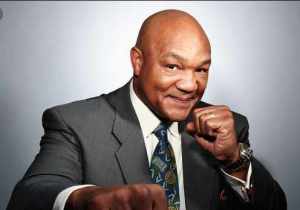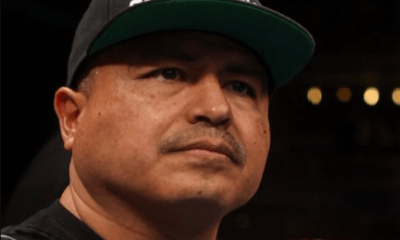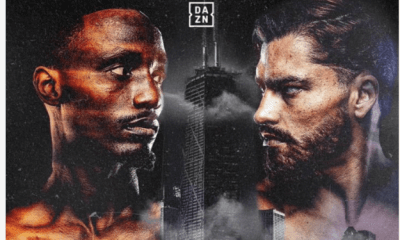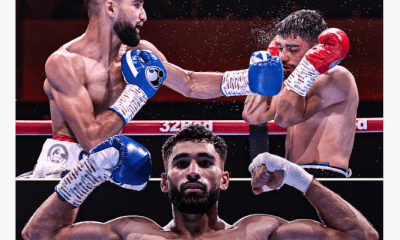Featured Articles
The First Coming of George Foreman: A Retrospective
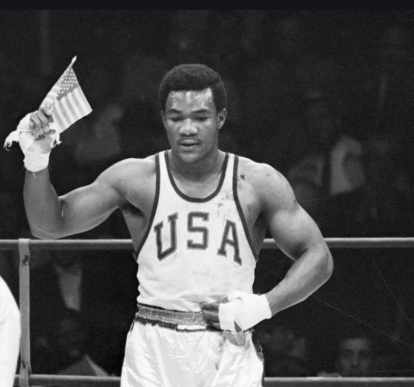
| This coming Oct. 30 is the 45th anniversary of the Ali-Foreman fight. Boxing has had its fair share of memorable fights across the decades, but few have been more talked about than “The Rumble in the Jungle.”
The 60,000 fans in attendance watching at the 20th of May Stadium in Kinshasa, Zaire and the record–setting one billion viewers taking it in around the globe, including 50 million who watched via pay-per-view on closed circuit television, will never forget what happened inside the ring. Foreman, who was recognized as the world heavyweight champion by the World Boxing Association and World Boxing Council, the only sanctioning bodies that mattered, entered with a 40-0 record and 37 knockouts. Ali owned a 44-2 mark with 31 knockouts, but wasn’t the same fighter after being stripped of his titles and missing three-and-a-half years between 1967 and 1970 after refusing induction into the military based on his religious convictions. Both stood 6-feet-3. Foreman weighed 220 pounds and Ali 216, but the latter was giving away seven years in age, 32 to 25. The fight commenced with Ali on the offensive, but Foreman, a 4-to-1 betting favorite, rallied to close the gap by the end of the opening frame. In the second round, Ali allowed “Big George” to bang away at his arms and body, using what he later described as the “rope-a-dope,” which helped tire Foreman out. As the fight continued, Foreman’s once fierce arsenal was reduced to half its potency and in the eighth round Ali eventually found his range. Ali now threw punches at will, and when Ali buzzed Foreman with a quick right and knocked him to the canvas, Zack Clayton, the referee, had seen enough. Having lost for the first time as a professional, Foreman was bitter and even claimed that his trainer and manager, Dick Sadler, put something in his water just minutes before the opening bell. “It’s not like the water beat me,” Foreman said in writer Jonathan Eig’s biography, “Ali.” “Muhammad beat me. With a straight right hand. Fastest right hand I’d ever been hit with in my life. That’s what beat me. But they put drugs in my water.” In time, though, Foreman would mellow, saying, “Before that, I had nothing but revenge and hate on my mind, but from then on, it was clear. I’ll never be able to win that match, so I had to let it go. It just wasn’t my night.” The Road to Zaire Foreman’s sweet and outgoing personality wasn’t on display when he began his pro career shortly after winning a gold medal at the 1968 Summer Olympics in Mexico City. To the contrary, Foreman was a mean and angry young man after spending his childhood in Houston’s tough Fifth Ward. Growing up with six siblings and without much on the table to eat will create a crusty exterior. Everyone needs an escape. Football was that for Foreman, who idolized Jim Brown, arguably the NFL’s greatest running back. But it was boxing that saved him and helped turn his hardscrabble life around. At 15, Foreman grew tired of high school and dropped out, joining the Job Corps. This is where he was introduced to boxing and through hard work and dedication went on to earn a berth on the U.S. Olympic boxing team, going on to win a gold medal at the 1968 Summer Games. This was a turbulent year. It was the year in which Dr. Martin Luther King Jr. and New York Senator Robert F. Kennedy, a Presidential hopeful, were assassinated. Blacks were rioting in many American cities over grievances including police harassment, the Viet Nam War was raging half a world away and college students were protesting our involvement in that very unpopular war. This was the ugly backdrop against which the 1968 Olympic Games were being contested. Two black American track stars, Tommie Smith and John Carlos, were front and center in Mexico City after placing first and third respectively in the 200-meter dash. At the medal stand, Smith and Carlos raised their clenched fists wrapped in black gloves skyward while the National Anthem played, which triggered a chorus of boos from those inside the stadium. Foreman waltzed through each round of the heavyweight tournament and took the gold medal by stopping Lithuania’s Jonas Cepulis, representing the Soviet Union, in the second round. Foreman then pulled out a small American flag and walked around the ring, bowing to the crowd. Many Americans fell in love with Foreman because of that simple gesture of waving the flag. “I had a lot of flak,” said Foreman years later of the flag-waving incident. “In those days, nobody was applauded for being patriotic. The whole world was protesting something. But if I had to do it all again, I’d have waved two flags.” Foreman’s professional career began in grand fashion in June 1969 at New York’s Madison Square Garden when he scored a third-round TKO over Don Waldhelm. The next six fights concluded by knockout or TKO before Foreman triumphed over Peruvian trial horse Roberto Davila by unanimous decision at the Garden in October 1969. Three more victories followed by knockout or TKO before Foreman registered a unanimous decision over journeyman Levi Forte in Miami Beach in December 1969. With three more wins coming by knockout or TKO, Foreman was now 15-0. In his next fight, Argentine veteran Gregorio Peralta extended him the 10-round distance, after which Foreman won 24 in a row inside the distance, including a 10th round TKO of Peralta in a rematch in May 1971 at the Oakland County Coliseum Arena where he grabbed his first championship belt, the North American Boxing Federation strap. Ten victories followed including a second round TKO over undefeated Joe Frazier in Kingston, Jamaica, in January 1973, where he took away Frazier’s WBA and WBC world title belts. Foreman then knocked out Jose Roman in the first round in Tokyo, Japan in September 1973 and followed that up with a second round TKO of Ken Norton in Caracas, Venezuela in March 1974. Then it was off to Zaire to meet Ali with the unified title at stake. Post-Ali In January 1976 Foreman returned to the ring after a 16-month absence and knocked out Ron Lyle in the fifth round at Caesars Palace in Las Vegas in The Ring magazine Fight of the Year. Four more wins by TKO would follow before losing a 12-round unanimous decision to Jimmy Young in March 1977 in San Juan, Puerto Rico. In the dressing room after the fight, Foreman, suffering from heatstroke and exhaustion, said he had a near-death experience in which he claimed to have been in a hellish place of nothingness and despair. Foreman pleaded with God to save him. Foreman said God told him to change his ways and at that moment he became a born-again Christian, dedicating his life to his Lord. Foreman stopped fighting and became a streetcorner evangelist before opening his own church, the Church of the Lord Jesus Christ in Houston. Foreman focused his attention on his family and congregation and opened a youth center in his name He was only 28 years old when he turned his back on boxing and a decade would pass before he would re-enter the sport. Second Coming In November of 1994, twenty years after he lost to Ali, Foreman, now 45 years old, upset Michael Moorer with a 10th round knockout at the MGM Grand Garden Arena and became the oldest fighter ever to win a championship. Regaining the title was a byproduct of Foreman’s desire to raise money for his congregation. Today, Foreman is a bigger-than-life personality who draws people to him. Young and old, black and white and everything in-between gravitate to the 70-year-old, two-time heavyweight champion like a magnet. Boxing did indeed rescue George Foreman who concluded his Hall of Fame career with 76 wins, five losses and 68 knockouts.
“If I hadn’t found boxing, I wouldn’t have been able to fulfill half of my dreams,” he said. “In fact, I didn’t know how to dream until I found boxing.” Very few fighters rise through the ranks and claim a world championship title. To replicate this achievement after being off for a decade is truly incredible. Check out more boxing news on video at The Boxing Channel To comment on this story in The Fight Forum CLICK HERE |
-

 Featured Articles4 weeks ago
Featured Articles4 weeks agoResults and Recaps from New York Where Taylor Edged Serrano Once Again
-

 Featured Articles1 week ago
Featured Articles1 week agoThe Hauser Report: Zayas-Garcia, Pacquiao, Usyk, and the NYSAC
-

 Featured Articles3 days ago
Featured Articles3 days agoOscar Duarte and Regis Prograis Prevail on an Action-Packed Fight Card in Chicago
-

 Featured Articles3 weeks ago
Featured Articles3 weeks agoResults and Recaps from NYC where Hamzah Sheeraz was Spectacular
-

 Featured Articles4 weeks ago
Featured Articles4 weeks agoFrom a Sympathetic Figure to a Pariah: The Travails of Julio Cesar Chavez Jr
-

 Featured Articles2 weeks ago
Featured Articles2 weeks agoManny Pacquiao and Mario Barrios Fight to a Draw; Fundora stops Tim Tszyu
-

 Featured Articles4 weeks ago
Featured Articles4 weeks agoPhiladelphia Welterweight Gil Turner, a Phenom, Now Rests in an Unmarked Grave
-

 Featured Articles2 weeks ago
Featured Articles2 weeks agoArne’s Almanac: Pacquiao-Barrios Redux

